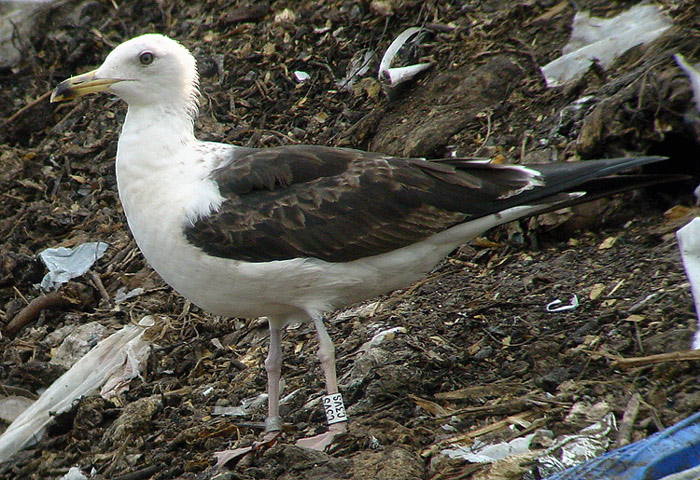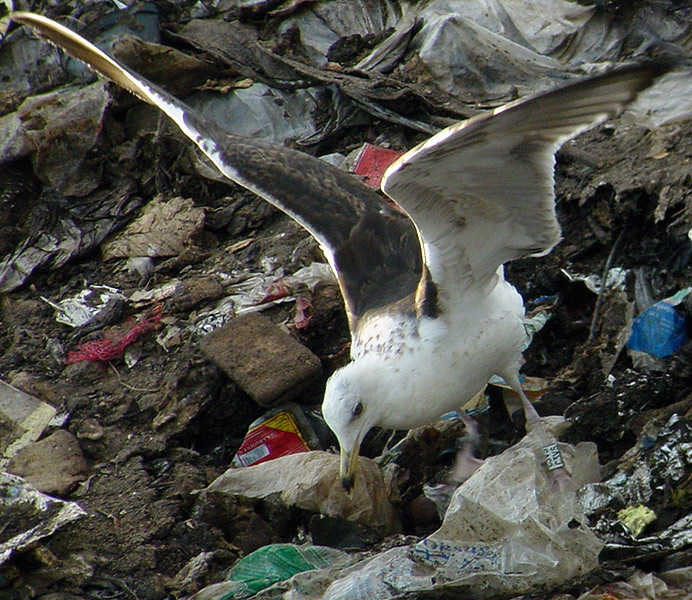(2 images) Larus fuscus fuscus 2cy C3VS July 16-17 2003, Tampere, Finland (61.33N 24.59E).
C3VS was ringed in Finland, probably as pullus last summer. An example of typical Finnish fuscus, representing average 2cy fuscus in completely moulted primaries, complete 2nd generation tail and secondaries. All wing-coverts have been replaced to 2nd generation on the wintering grounds, and by mid July, a next moult wave has been initiated, including the median and lower lesser coverts, the inner greater coverts, upper tertials and scapulars. Note the yellow base of the bill and pinkish legs.
In all respects, it's classic Finnish fuscus: moult scores of remiges, rectrices and wing-coverts, the jizz: an elongated and delicately built bird. The bare part colouration is pretty advanced for 2cy birds, especially when compared to 2cy argenteus, argentatus, graellsii or intermedius from NW Europe. The bill-base is largely yellow and there is already some red of the gonydeal spot visible on the lower mandible. The legs are pink and the iris is becomes amber brown.
Many 2cy fuscus in Finland have the body feathers and head moulted to plain white feathers, with only limited mottling on the sides of the breast and flanks. It's common to find 2cy birds moulting the head in July, as is often indicated by the 'moth-eaten' appearance.
The upper-part moult in the scapulars is advanced, with most scapulars replaced for 3rd generation feathers. The last 2nd generation scapulars can be found in the lowest row of scapulars; they are bleached brown and worn at the fringes.
Typical Finnish fuscus in July have replaced primaries, rectrices and secondaries, all moulted in a complete post-juvenile moult on the wintering grounds, prior to northbound migration. The new second generation primaries are only a couple of months old and still look dark blackish. The second generation tail-feathers normally still show the white tips, but in some individuals these tips are worn away when 2cy birds arrive back in Scandinavia. Immediately after returning in Scandinavia some 2cy fuscus start a new moult cycle in the inner primaries, now growing in third generation feathers.
The complete moult in the winter quarters normally start with replacement of the scapulars and mantle-feathers in November to January, but the post-juvenile moult may already start in juvenile birds which are still in Scandinavia in September. The new scapulars often show a simple pattern of a black shaft-streak on a dark brown base. When most of the scapulars are replaced, fuscus start to replace the wing-coverts, in the ordinary sequence that can also be found in other gull taxa in Europe. Wing-covert moult is initiated in two loci, one wave starts in the outermost coverts, one wave starts in the innermost coverts. The two waves normally meet at covert #7-8. Normally the median covert row is the first row which is moulted, followed by the lower lesser coverts, the greater coverts and moult finishes in the outer lesser coverts (the carpal edge). If for whatever reason, moult in the wing-coverts is arrested, this is normally most obvious in the carpal edge and outer greater coverts, containing juvenile feathers which contrast with the other fresh coverts.
In classical 2cy fuscus, all wing-coverts are replaced to second generation on the wintering grounds, and by mid July in Scandinavia, a next moult wave is initiated, often including the median and lower lesser coverts, the inner greater coverts, upper tertials and scapulars. Bare part coloration may be very immature, including a black bill, but may also be very mature, with a yellow base and a red gonydeal spot on the lower mandible. Still, these birds are only 12 months old.


|
 nominate Lesser Black-backed Gull (L. fuscus)
nominate Lesser Black-backed Gull (L. fuscus)
